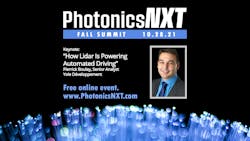According to the 2021 lidar report from Yole Développement (Yole; Lyon, France), lidar in advanced driver-assistance systems (ADAS) represented just 1.5% of the automotive and industrial lidar market last year. By 2026, the report estimates that the ADAS proportion will reach 41% and a market size of $2.3 billion. That’s a 111% compound annual growth rate from 2020 to 2026. Since the invention of 3D real-time lidar, more than 80 lidar companies have been established. Many of them have bet on new technologies.
This has resulted in high technological diversity in the lidar landscape. Despite this great diversity, the oldest technologies are still representing most design wins for the automotive industry. Considering the lidar wavelength, 1550 nm is less dangerous to the human eye than 905 nm and promises integration through silicon platforms. However, 905 nm represents 65% of design wins for the automotive industry.
According to the report, traditional mechanical scanning represents 69% of design wins for the imaging method. MEMS micromirror and flash lidar are also making their way into automotive, but their proportion is smaller. Concerning the ranging method, direct time-of-flight (dToF) represents 100% of design wins. Frequency-modulated continuous-wave, which allows better integration, sensitivity, and instant radial velocity, is not expected before 2025.
I’m pleased to invite you to join us on October 28, 2021, at the PhotonicsNXT Fall Summit keynote presentation, where Yole senior market and technology market analyst Pierrick Boulay will explain how lidar is becoming a key sensor for automated driving. Boulay will give a complete analysis of lidar technologies used for ranging and imaging, automotive integration, software challenges, and components used for light emission and photodetection. I hope you’ll join us for this lidar ecosystem overview and deep-dive into the status of automotive integration.

